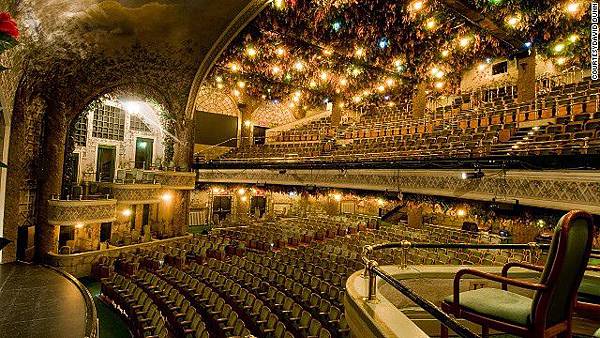15 of the world's most spectacular theaters

(CNN) -- April 23 is, according to some reports, William Shakespeare's birthday.
In a nod to the Bard's enduring legacy 450 years on from his birth, as well as the UK's theatrical history, here are a few stages worth seeing, whether a play's being performed or not.
Shakespeare's Globe theater (London)
The original Globe theater was built by Shakespeare's company, the Lord Chamberlain's Men, in 1599, but was destroyed by fire in 1613.
A replica was built in 1997 just meters from the original site, with historical records used for guidance.
Though almost identical in appearance to the original, the new 857-seat structure has several modern features, including roof-based sprinklers and a concrete theater pit, as opposed to the straw-strewn one that would have existed in 1599.
One feature faithfully recreated is the roof -- Shakespeare's Globe has the first and only thatched roof permitted in London since the great fire of 1666.
Shakespeare's Globe, 21 New Globe Walk, Bankside, London; +44 20 7902 1400
MORE: 10 of the world's most enjoyable movie theaters
The Düsseldorfer Schauspielhaus (Düsseldorf, Germany)
The history of this German theater dates to 1818, when King Friedrich Wilhelm II of Prussia presented it to the residents of Düsseldorf as a gift.
The modern theater that now stands on the original site was built in the late 1960s.
Its curved, undulating lines are designed to resemble a theater curtain.
Architect Bernhard Pfau's design was chosen in a competition.
The Düsseldorfer Schauspielhaus, Gustaf-Gründgens-Platz 1, Düsseldorf, Germany; +49 211 85230
Balboa Theatre (San Diego)
The Balboa Theatre was built in 1924 and named after Spanish explorer Vasco Nuñez de Balboa -- the first European to discover the Pacific Ocean.
The property fell into disrepair, but in 2002 a major restoration began.
A replica of the theater's sign, depicting Vasco's ship, was created using original colors identified from photographs, and stencils were used to painstakingly recreate the tapestry design that once adorned the walls.
"After a $26 million renovation, this elegant vaudeville theater has been fully restored, complete with its one-of-a-kind, fully operational interior waterfalls," says Ken Stein at the League of Historic American Theaters.
"If you could sum up the beauty of the City of San Diego in a single design, this would be it."
Balboa Theatre, 868 4th Ave., San Diego; +1 619 570 110
BAM Harvey theater (New York)
The BAM Harvey opened in 1904 as a venue for Shakespearean plays, vaudeville revues and musicals.
It was converted into a cinema in 1942, before dancer Harvey Lichtenstein commissioned architect Hugh Hardy to refurbish the interior so it could operate as a theater again.
Today's structure incorporates the original columns and water-stained ceilings, giving the venue a Greco-Roman feel.
"The 1987 restoration preserved the ornate detail and retained its historical associations, while rebuilding the stage and stripping it out to the bare brick back wall," says Professor Arnold Aronson at Columbia University's theater arts program.
"It was one of the most exciting theater renovations of the past three decades."
BAM Harvey theater, 651 Fulton St., Brooklyn, New York; +1 718 636 4100
MORE: Seoul's 4D theater takes special effects way too seriously
National Noh Theatre (Tokyo)
Forget cement and plasterboard -- Japan's Noh theater was constructed in 1983 from 400-year-old bishu-hinoki cypress trees.
It's open on three sides and the seating spreads out from the stage in a fan shape.
Despite the traditional elements there's plenty of tech -- each seat has a personal subtitling system that can be changed from Japanese to English at the touch of a button.
Noh (meaning "skill" or "talent") is a form of traditional Japanese musical drama, and plays often last all day.
National Noh Theatre, 4-18-1, Sendagaya, Shibuya-ku, Tokyo; +81 3 3423 1331
Salle Richelieu (Paris)
The Salle Richelieu, also known as the Comédie Française, was built in the late 1600s.
The grand staircase is lined with busts of important figures from the theater's past -- the bust of French playwright Corneille is rather worn, due to the belief that touching it will bring good luck.
"It's the archetypal theater -- a womb-like curve of red plush and gold," says professor Jan Clarke at the International Federation for Theater Research.
"It's also a living museum, containing objects, artifacts, paintings and sculptures of huge interest for the history of French theater, including the armchair actor Jean-Baptiste Poquelin used in 'Le Malade Imaginaire' just hours before his death."
The Salle Richelieu, 8 Rue de Montpensier, Paris; +33 1 44 58 15 15
Minack Theatre (Cornwall, UK)
The setting is so stunning at this cliff-edge theater that you might find yourself getting distracted.
On the plus side, the roaring waves could be a blessing for those who've forgotten to turn their phones off.
The theater was the brainchild of the late Rowena Cade, who decided to allow her garden to be used by a local theatrical group.
In 1932, Cade, with the help of her gardener, hauled several tons of rock from the beach below and created a more permanent venue, which she opened to the public.
Today, there are performances between June and September, though the theater remains open all year round.
Minack Theatre, Porthcurno, Penzance, Cornwall, UK; +44 1736 810694
MORE: Spectacular beach art that's destroyed at high tide



 留言列表
留言列表


